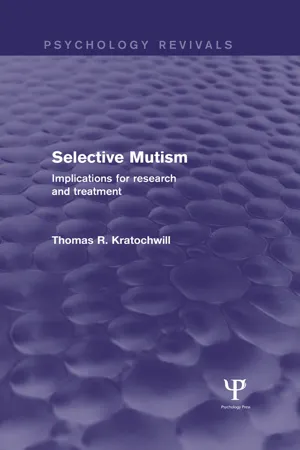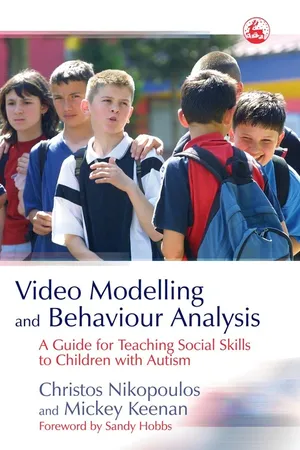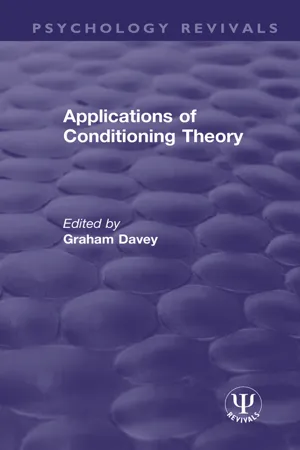Psychology
Behaviour Modification
Behavior modification is a psychological approach that focuses on changing an individual's behavior through various techniques such as positive reinforcement, negative reinforcement, and punishment. It aims to promote desirable behaviors and reduce or eliminate undesirable ones by shaping and conditioning behavior through systematic and structured interventions. This approach is often used in clinical, educational, and organizational settings to address a wide range of behavioral issues.
Written by Perlego with AI-assistance
Related key terms
1 of 5
6 Key excerpts on "Behaviour Modification"
- eBook - ePub
Selective Mutism (Psychology Revivals)
Implications for Research and Treatment
- Thomas R. Kratochwill(Author)
- 2015(Publication Date)
- Psychology Press(Publisher)
4 Behavior Modification: A PerspectiveThis chapter is intended to provide a general overview of current issues in behavior modification, particularly its use in applied settings. There are literally hundreds of texts dealing with various aspects of behavior modification, and the interested reader is referred to some primary sources for a comprehensive overview (Bandura, 1969; Catania & Brigham, 1978; Craighead, Kazdin, & Mahoney, 1976; Gelfand & Hartmann, 1975; Kazdin, 1980a; Marholin, 1978; Sulzer-Azaroff & Mayer, 1977). This chapter is primarily designed to elucidate certain features of the behavioral approach that help set it apart from the psychodynamic view discussed in Chapter 2 . It does not deal with critical issues in the area of controversy or attempt to embrace the many new dimensions of behavior modificaion such as the use of cognitive therapeutic procedures (e.g., Meichenbaum, 1977) and self-control techniques (e.g., Mahoney & Thoresen, 1974; Thoresen & Mahoney, 1974).Scope of Behavior ModificationIt is useful to clarify the relation between behavior modification and the broader concept of behavior influence. Stolz, Wienchowski, and Brown (1975) contrasted these two concepts by suggesting that whereas behavior influence occurs whenever one person exerts some degree of control over another (e.g., formal education, child rearing, interpersonal interactions), behavior modification refers to a special form of behavior influence that involves the application of principles derived from research in experimental psychology to alleviate human suffering and enhance human functioning (p. 1027). In many respects, the behavioral model of deviant behavior that developed out of psychological research helped to provide an identity to psychology independent of medicine where psychodynamic approaches were closely aligned. In addition to providing a unique perspective in the treatment of deviant behavior, the behavioral approach provided an important alternative to the disease model of deviant behavior (as outlined in Chapter 2 and demonstrated in one area of child practice in Chapter 3 - eBook - PDF
Video Modelling and Behaviour Analysis
A Guide for Teaching Social Skills to Children with Autism
- Mickey Keenan, Christos Nikopoulos(Authors)
- 2006(Publication Date)
- Jessica Kingsley Publishers(Publisher)
CHAPTER 3 Modelling from a Behavioural Point of View Video Modelling in Context There must be a beginning of any great matter, but the continuing unto the end until it be thoroughly finished yields the true glory. Francis Drake , Dispatch to Sir Francis Walsingham (17 May 1587) 3.1 Introduction Applied Behavior Analysis (ABA) is a strongly empirical scientific field that relies on the experimental analysis of behaviour. Specifically, it is a science that seeks to use empirically validated behaviour change procedures in an effort to assist people in developing skills with social value (Baer et al . 1968; Skinner 1953). Thus, ABA should not be regarded as a specific intervention technique, rather it is an overall science which delivers services to establish, guide and evaluate intervention programmes across different people and contexts (Jensen and Sinclair 2002). It regards any behaviour as functional and purposeful, which consists of a complex blend of factors relevant to the individual’s strengths and limitations, physical status, personal history and the current social-environmental circumstances (Romanczyk and Matthews 1998). Behaviour analysis has well-established roots in the field of conceptual training and programmed instruction (Grant and Evans 1994). Therefore, any treatment procedure is structured according to the established principles of the general philosophy of this science. Most of the treatment procedures are governed by a combination of these principles or, alternatively, more than one 59 principle constitutes a treatment procedure. However, there are instances wherein a treatment procedure is formed by only one conceptual principle. Thus, within the general conceptual framework, behavioural principles could also be treated as treatment procedures. Positive reinforcement, prompting, shaping, chaining, fading and modelling, among others, are referred to as behavioural principles as well as specific procedures in any treatment (e.g. Leslie 2002). - eBook - PDF
- Werner Hoeger, Sharon Hoeger, , Cherie Hoeger, Wener Hoeger, Werner Hoeger, Sharon Hoeger, Cherie Hoeger(Authors)
- 2021(Publication Date)
- Cengage Learning EMEA(Publisher)
Due to electronic rights, some third party content may be suppressed from the eBook and/or eChapter(s). Editorial review has deemed that any suppressed content does not materially affect the overall learning experience. Cengage Learning reserves the right to remove additional content at any time if subsequent rights restrictions require it. Chapter 2 Behavior Modification 41 GLOSSARY Behavior modification The process of permanently changing negative behaviors to positive behaviors that will lead to better health and well-being. Personal Profile Personal Behavior Modification Profile Are you able to answer the following questions regarding behavior change? If you are unable to do so, the chapter contents will help you do so. I. Can you list the processes of change that most helped Sharon adhere to her fitness program? ______________ _______________________________________________ II. Can you identify behavioral changes that you have consciously made in your life and the process that you went through to do so? ______________________________________________ III. Would you categorize yourself as having an internal or external locus of control? (Do you believe you can take charge of your own life [internal locus of control] or do you feel victim to forces beyond your control [external locus of control]?) ____ IV. Can you identify your current stage of change for phys- ical activity? How about exercise? (Are you not yet ready to consider exercise? Contemplating exercise? Making preparations to fit exercise in your life? Currently exercising regularly? Or have you exercised regularly for 5 years or more?) ________________ looking at any physical fitness and wellness guidelines, take a critical look at your behaviors and lifestyle—consider the per- manent changes you need to make to promote your own well- ness. This chapter will help you understand and apply behavior modification techniques. - eBook - PDF
Developments in Psychotherapy
Historical Perspectives
- Windy Dryden(Author)
- 1996(Publication Date)
- SAGE Publications Ltd(Publisher)
In the field of learning disability, no set of interventions has attracted more interest or more debate than behaviour modificat ion. The debate has been caused chiefly by worries about ethics which have occupied both behaviour therapists and their critics for many years, whilst the interest resulted both from the growing awareness of the effectiveness of be-havioural techniques in learning disability and a more general change in perception on the part of both professionals and carers towards a belief that even severely impa ired people are educable. As with much of the work on operant condit ioning, the early literature came from the USA. Case studies and single case experiments formed the bulk of the early literature during the 1960s. By the beginning of the next decade, group studies had begun to accumulate (see Yule and Carr, 1987 for a comprehensive account of the status of behaviour therapy with learning disabilit ies), and a number of key texts had been published (e.g . Gardner, 1971). Apart from the important message of hope regarding the teachability of people with learning disab ili-ties, the other important contribution was the training of non-psychologists and non-clinic ians in the treatment methods used (Yule, 1975). By the mid-1970s, behaviour therapy was the mainstay of education of people with learning disab ilit ies. Although the term behaviour therapy is currently somewhat unfashionable in learning disability circles, where approaches such as 'gentle teaching' (McGee, 1990) have attracted considerable inter-est, behavioural methods remain at the heart of such teaching today. In Behaviour Therapy 175 remedial education programmes and education of people with learning disab il it ies, behavioural princ iples continue to exert a major influence, and make a considerable contribut ion to the quality of life of these ind iv iduals. - Rajinder M. Gupta, Frederika C. Theus(Authors)
- 2006(Publication Date)
- Wiley(Publisher)
However, our more recent experience of working in different clinics in the last ten years would suggest that, if we were to repeat this survey, we would be likely to obtain similar results. We will even go as far as saying that, in our considerable experience of working in different setups, we have never come across any psychologist using traditional forms of Behaviour Modification. 102 PARENTING FOR MENTAL HEALTH SERVICE PROFESSIONALS As well as referring to some of the published literature, Gupta and Coxhead (1990) outlined some of the reasons why in clinical settings, or for that matter in schools, Behaviour Modification in its traditional format is difficult to implement. For instance, Hyman and Lally (1982) observed that traditional Behaviour Modification does not adequately deal with the question of generalisability, its poor reliability, and its unsatisfactory experimental design. Kazdin (1980) has criticised traditional Behaviour Modification for lack of ‘social’ validation. According to Bolton et al. (2003; see also the studies cited therein): ‘While intervention aimed at modify-ing parenting skills is important, purely behavioural models of treat-ment may neglect emotional and cognitive features of parent–child interaction’ (p. 242). Tharp and Wetzel (1969), drawing on their experience of using Behaviour Modification in ‘natural settings’, concluded as follows: In the natural environment, however, things do not work out with such simplicity. Adequate reinforcers are not always available, either for the target or mediators. Logistical problems are sometimes insurmountable. Indeed, few cases did not include at least one form of these resistances, most resisted in several ways . . . The point made here is that these resistances cannot be assumed unique to any one case. They represent technical difficulties which must be faced by anyone who chooses to attempt Behaviour Modification in the natural environment.- eBook - ePub
- Graham Davey(Author)
- 2017(Publication Date)
- Routledge(Publisher)
However, arguably the most important outcome of OBM research has been the light it has cast on the inefficiency of organizations produced by 'sloppy' contingency management. All work organizations require of their participants that they meet certain behavioural requirements (e.g. being present during certain hours of the day and indulging in certain specified 'work' behaviours); yet apart from informing the member that this is what he should do, there is little attempt made to ensure that the environmental contingencies in the organization are conducive to generating or maintaining these behaviours. The following sections deal with the kinds of analyses necessary for identifying contingency management problems (e.g. identifying the causes of behaviour, identifying appropriate reinforcers, and setting up appropriate contingen cies), and concludes with a discussion of some actual applied studies and some critical issues which extend beyond the mere academic application of Behaviour Modification principles to organizations. Organizational Behaviour Modification Organizational Behaviour Modification is that branch of psychology which attempts to relate operant conditioning principles to organizational behaviour. It tries to achieve this in three ways. Firstly, by attempting to operationalize traditional organizational terminology into a language which involves only measurable and observable events, whether they be environmental or behavioural. Secondly, by allocating the causes of behavior to the contingencies which exist between environment and behaviour; this involves analysing the antecedents and consequences of organizational behaviour and identifying actual and potential reinforcers and punishers. And, thirdly, by manipulating the contingencies of reinforcement avaiable in organizations in order to facilitate organizational performance and productivity. The following sections explore some of these aims and achievements in more detail. Internal states vs
Index pages curate the most relevant extracts from our library of academic textbooks. They’ve been created using an in-house natural language model (NLM), each adding context and meaning to key research topics.





